- News
- Reviews
- Bikes
- Accessories
- Accessories - misc
- Computer mounts
- Bags
- Bar ends
- Bike bags & cases
- Bottle cages
- Bottles
- Cameras
- Car racks
- Child seats
- Computers
- Glasses
- GPS units
- Helmets
- Lights - front
- Lights - rear
- Lights - sets
- Locks
- Mirrors
- Mudguards
- Racks
- Pumps & CO2 inflators
- Puncture kits
- Reflectives
- Smart watches
- Stands and racks
- Trailers
- Clothing
- Components
- Bar tape & grips
- Bottom brackets
- Brake & gear cables
- Brake & STI levers
- Brake pads & spares
- Brakes
- Cassettes & freewheels
- Chains
- Chainsets & chainrings
- Derailleurs - front
- Derailleurs - rear
- Forks
- Gear levers & shifters
- Groupsets
- Handlebars & extensions
- Headsets
- Hubs
- Inner tubes
- Pedals
- Quick releases & skewers
- Saddles
- Seatposts
- Stems
- Wheels
- Tyres
- Health, fitness and nutrition
- Tools and workshop
- Miscellaneous
- Tubeless valves
- Buyers Guides
- Features
- Forum
- Recommends
- Podcast
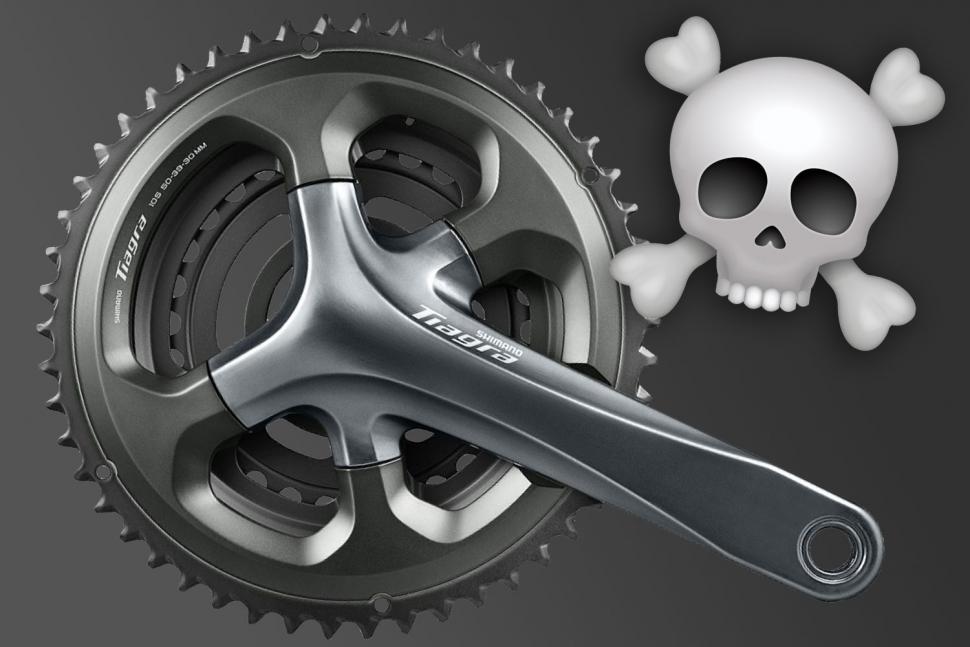 The death of the triple chainset August 2018
The death of the triple chainset August 2018Are we seeing the death of the triple chainset?
Triple ring chainsets have fallen out of fashion in recent years, but are they threatened with extinction?
Modern road bikes can come with any one of a number of different types of chainset fitted as standard - there's standard, compact and semi-compact chainsets for starters. But just because your bike came fitted with a certain type of chainset doesn't necessarily mean it's the right one for you.
We asked SRAM, Shimano and Campagnolo if they feel that the triple chainsets days are numbered. Here are their replies:
Campagnolo
Campagnolo hasn't introduced any new triple chainsets since 2012, but their Athena 11-speed, and Centaur and Veloce 10-speed triples are still available.
Campagnolo told us:
While most athletes are covered by the gearing offered by compact chainsets and larger cassettes, there are still a faithful few who are quite keen to use the triple. Several requests from areas in France, Belgium and Canada strangely enough.
However, with the advantages of the compact crankset and a movement towards larger tooth count cassettes we believe that those wishing to run a triple ring crankset will diminish further as they will adopt increasingly more often the two chainring solution. At the moment we still offer the triple.
SRAM
As we mentioned above, SRAM has never bothered with road bike triples, and in recent years has been promoting single-chainring gear systems as the ultimate in simplicity even for racing. What they had to say about triples isn't very surprising then:
Is the triple chainset dead?
Dead & buried.
Where do you see the future of modern road bike chainsets?
There’s a bright future for 1x. Simpler, quieter, more secure. Current cassette options allow gear range for most cycling disciplines. 1x even provides a more aerodynamic drivetrain for TT and triathlon. 2x remains dominant, of course, because it can provide the widest gear range and closer gear ratio steps.
Shimano
You could once get a Dura-Ace triple chainset if you were building a very posh pass-stormer, but no more. As its top-end groupsets switched from 10 to 11 sprockets, Shimano quietly dropped triples.
Shimano told us:
Within Shimano's current road line up triple chainsets are more common at Tiagra level and below. These groupsets attract a wider audience/riding style and therefore the demands on the components are different to those favoured by competitive and performance cyclists.
Triple chainsets have closer gear ratios, making the steps between the gears easier to move through, and therefore increasing the efficiency of personal performance. For many riders, a triple chainset provides options to allow you to continue cycling in many circumstances/conditions.
However, at the competitive end of cycling, trends for many years have been in favour of double chainsets. Wider cassette ratios are now able to cover the vast majority of gear ranges, in combination with lower crankset weight values that performance athletes demand.
Which chainset is right for you?
So if the triple is dead, what are your common choices? Let's go through the main road systems to help you find the right one for you.
53/39 'Standard' or racing set-up
Ideal for: Pros, strong riders, or flat conditions (maybe a bit more than that but you get my drift)
50/34 'Compact'
Ideal for: Most people, good all-rounder ideally suited to hilly conditions
52/36 'Semi-compact'
Ideal for: Increasingly pros, but also the rest of us mortals too, strong all rounder, ideal for hilly conditions, paired with 11-32 cassette should get most people up even the biggest mountains.
48/32 and 46/30 'Sub-compact'
Ideal for: Touring, gravel and adventure bikes, it takes the existing idea of the compact chainset a step further, yielding gearing that’s ideal for bikes used across a range of surfaces and terrains
1x11 single chainring
Ideal for: Cyclocross, gravel and adventure riding. The single ring and wide-range (10-42t) cassette provides much of the range of a compact and shifting simplicity along with increased mud and ground clearance
- Read more: Which chainset is right for you?
The compact killed the triple
Gearing options have increased substantially over the years with the advent of the compact chainset the biggest reason for the demise of the triple. The arrival of the compact immediately sparked debate surrounding the death of the triple chainset, and they’re now much less noticeable in any of the big three groupset manufacturers - SRAM, Shimano and Campagnolo - ranges than they used to be.
Before the compact came along, your crankset choice was largely split between a double for racing and a triple for touring and Audax riding. At this time of limited choice, a triple was appealing for any non-racing applications, particularly touring or Audax bikes laden with luggage, the lower gears helping to spin up the climbs.
The new wave of sportive bikes sparked the development for a chainset that offered most of the range of the triple but with better chainline, lower weight and, arguably, better looks on a sporty carbon bike.
- Struggling on the hills? If you need lower gears to make climbing easier, here's how to get them
The compact was an instant success. Popularised by FSA soon after the turn of the century, the company met these sportive bike requirements and when paired with the increased range of the 10-speed cassettes introduced at roughly the same time, provided most of the same low gearing as a typical triple setup.
A triple does offer a wide range of gears, but there is a lot of duplication. A 50/34 compact with a 12-29 11-speed cassette provided minimal difference in range from a 53/42/30 triple with a 13-29 cassette. The small compromise in reduced gear choices and range was compensated by reduced less gear duplication, lower groupset system weight and a narrow Q-factor.
Compacts were even used in professional races too, Tyler Hamilton using a compact on a mountain stage of the 2003 Tour de France. The fate of the triple for the new breed of performance focused sportive bikes and cyclists was sealed forever.
The chainset evolution
The evolution of the chainset and the reduction of the number of rings has been helped by the growing cassette range and increased gears of each subsequent groupset release. Back in the day, you’d be lucky with a 6-speed, 11-23 cassette, fine for racers, but the only way to get low gears without huge gaps — for touring, Audax or leisure cycling — was to fit a triple chainset.
With the advent of 9, 10 and 11-speed groupsets and an increased cassette range, with 11-30 and 11-34 now common options, there’s less need for a triple chainset. You can now get a wide spread of ratios with less duplication of gears.
A triple chainset is essentially a double with a smaller chainring bolted on. Triple chainsets require special front derailleurs and shifters, along with a matching long cage rear derailleur to accommodate the long chain needed to cover the full range of sprocket options. Reducing the need for specific components was a boon to manufacturers as it tidied up product lines.
And so they fell out of favour with manufacturers. Shimano and Campagnolo wasted no time dropping triples from their top-end ranges, Dura-Ace and Record respectively, replacing them with new compacts. SRAM didn’t even make a triple chainset when it first got into the road bike groupset market, and has been a proponent of the single ring drivetrain.
Now there are an increasing array of options. The semi-compact (52/36t) has been a hit, popular with racers and performance minded cyclists, and some reckon it even threatens the compact.
More recent is the sub-compact (48/32 and 46/30) for adventure and touring cyclists where lower gears for tackling hillier terrain with heavier bikes are required. With a 46/30 and an 11-34 cassette you're looking at the kind of gear range that used to be only easily achieved with a triple, and it's possible to go even wider and lower if you bend the rules a bit.
- First look: Does the Praxis Works Alba 48/32 herald the era of the sub-compact chainset?
Add to the mix too SRAM’s 1x11 approach, which pairs a single chainring with a super wide-range cassette, and it looks like the triple chainset has been pushed to the very fringes of cycling.
Do you think the triple is dead or is there still a place for it?
David worked on the road.cc tech team from 2012-2020. Previously he was editor of Bikemagic.com and before that staff writer at RCUK. He's a seasoned cyclist of all disciplines, from road to mountain biking, touring to cyclo-cross, he only wishes he had time to ride them all. He's mildly competitive, though he'll never admit it, and is a frequent road racer but is too lazy to do really well. He currently resides in the Cotswolds, and you can now find him over on his own YouTube channel David Arthur - Just Ride Bikes.
Latest Comments
- mctrials23 4 sec ago
Part of it is that but a large part of it is just deeply ingrained hatred of cyclists because cyclists are blamed for ridiculous things and drivers...
- chrisonabike 11 min 51 sec ago
The exact situation shown in this photo is pretty common near me....
- brooksby 1 hour 13 min ago
Nope - had an urgent appointment with his tax advisor
- brooksby 1 hour 17 min ago
I'm not sure which one of them looks more like a crook…
- OnYerBike 1 hour 50 min ago
It might not be Miche-specific, but across all the thru-axle, disc brake wheelsets in my household (including Hope, DT Swiss and Bitex hubs), none...
- S.E. 4 hours 2 min ago
That made me think of that "Hot Fuzz" comedy movie... so many truths in it.
- Rendel Harris 5 hours 54 min ago
Good to see a V-brake option available for all those people who ride Cosmic Elites with V-brakes...seriously, you must know really that the answer...
- mattw 6 hours 32 min ago
Get thyself over to Buildhub - a community owned forum where I am on the moderation team ("Ferdinand") which is about self-build and renovation....
- Destroyer666 16 hours 36 min ago
Nonono, not those, but those that have constructed Italian cars and motorcycles that have been driven to hundreds of race and championship...
- RoubaixCube 16 hours 45 min ago
This may well be the case although Im unaware of the brands popularity on their home turf. I used to see them being advertised more in the UK...
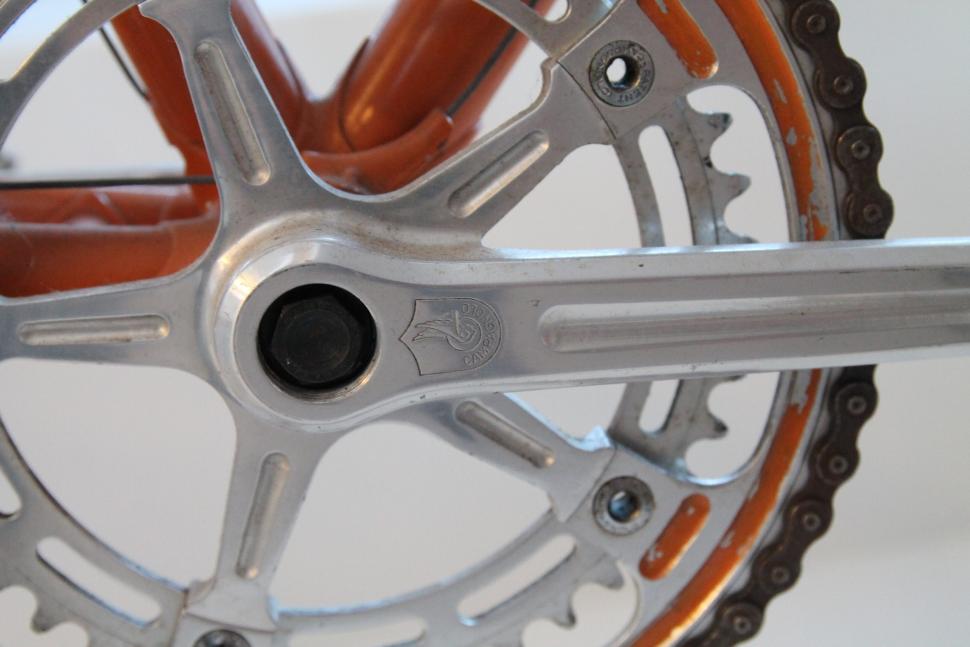
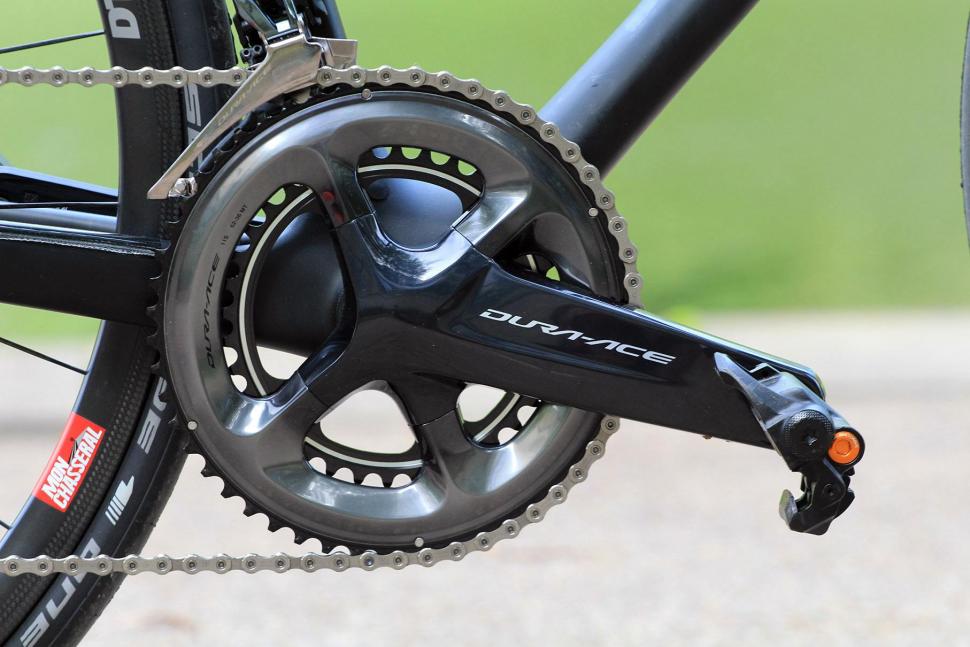
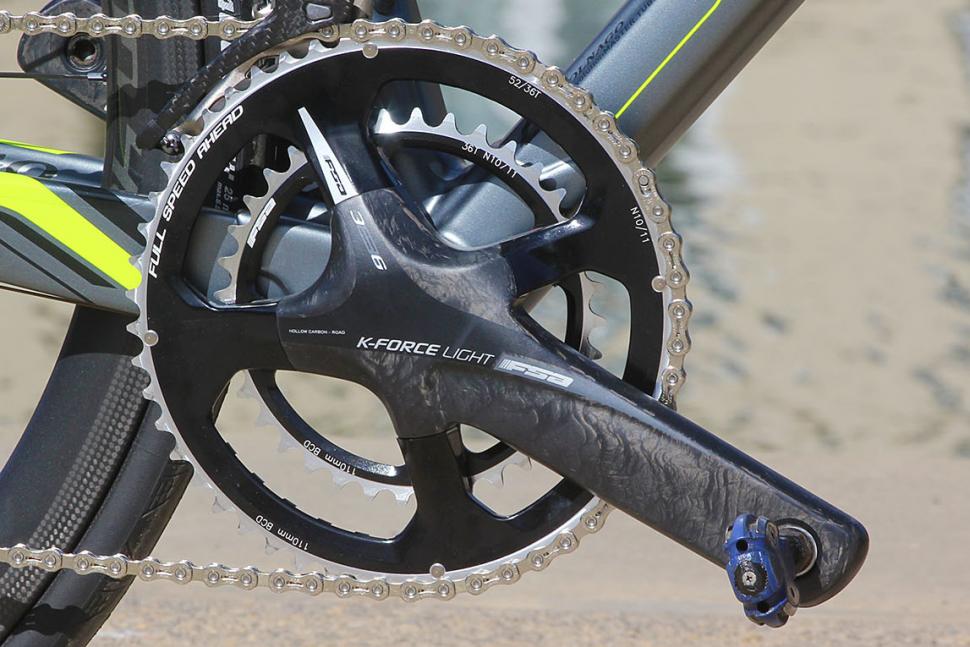
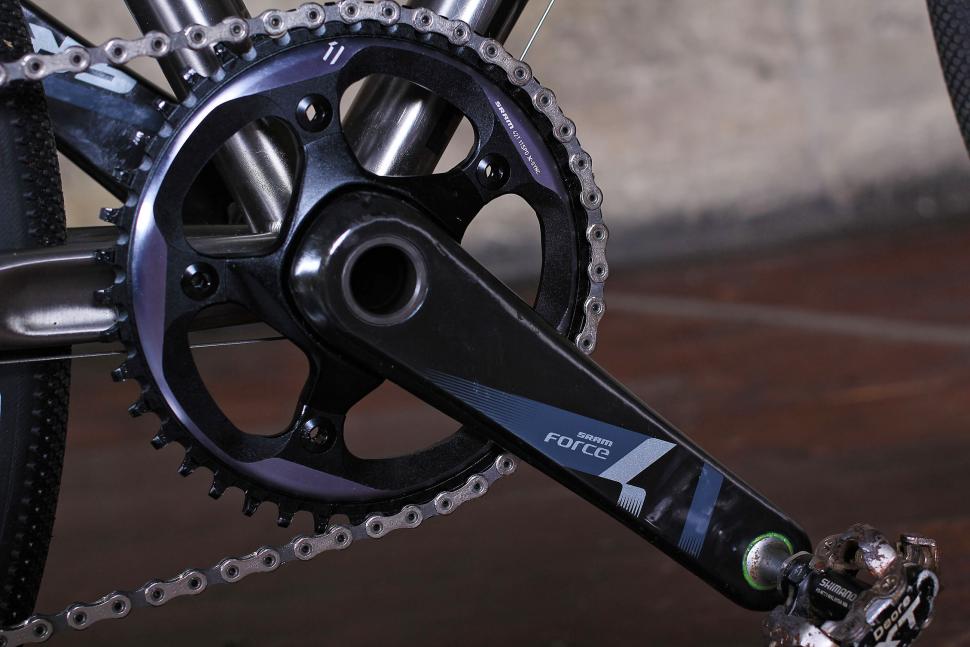
Add new comment
128 comments
Just like steel frames, Brooks saddles, wool baselayers and many other things that are considered 'old hat' in the perennial drive to sell you yet more new stuff.
Oh but, they do. They DO! And they will tell you so with remarkable conviction.
I don't know if it's coincidence but it appears that the people who need 52x11 to be able to ride downhill also seem to need 34x32 to go up it as well.
Big guys and I'm one of them don't need a 52x11 for downhills. Gravity works just aswell. I was out for a group ride at the weekend and even on 4% declines I was freewheeling,sat up on the hoods and still overtaking riders pedalling pretty quickly. 50,52,53 have there place and i use them on my bike for TT. The rest of the time gear down and spin.
Rolling resistance
Drafting effect
Aerodynamics
Mechanical losses in drivetrain
Take your pick, but nothing to do with your weight, unless the laws of physics have changed.
Heavier riders descend faster than lighter riders for less effort-fact. Regarding rolling resistance i was using my training tyres, 40mm G Ones :). The rest of the group 25/23mm road tyres.
I'm pretty quickly out of my depth on this stuff but does this explain it - you're the coin and they're the feathers? Or maybe those fat tubeless tyres really do 'roll well'!
www.bbc.co.uk/education/guides/zff82hv/revision
PS surely "time remaining before terminal velocity" should be available on Strava Premium?
in theory, heavier riders accelerate at the same rate but will have a higher top speed - given that you can get over 100kph with a 53x11 - you're going to have to be going some to make good use of it.
Over the last few years my retro-grouch hankering for triples has declined, though I still find the jumps on a compact too large if running a 12-32 (I am still on 10 speed). The sub compact and 11speed would probably get rid of that problem, but I am not spending money to upgrade to 11sp, happy to have all my bikes on 10sp for the foreseeable.
I still really like my triple on Audax bike though - (28-38-48 x 12-27) gives a lovely spread of gears (not range, that's easy, it's where the cogs fall into your cadence that counts!) I also have bar end levers on that bike too after being driven quietly mad on Paris-Brest-Paris by STIs that no one seemed to be able to get right (fecking 105-5700, yuk).
In the past I have done really silly things like run triples with straight blocks, which, in the days of 7 and 8 speed gave a wonderful range and very narrow spread - no wasted ratios. I still think a 3x8 with friction levers is probably the strongest most durable and flexible gear set around and one I would consider had I the luxury of riding around the world.
And I think Campys Racing triple was probably one of the prettiest groupsets ever. God I am sad.
But yes, more choice is good, and STIs make setting up triples an utter sh*t festival.
I built my Tripster up with 40/28 chainring and swap the rear wheel with either 11-40 or 11-32 cassette. It has a low gearing of 18" high gearing of 96". I can ride up mountains and also do pacey club runs with my bike.
Most people don't need a 48, 50,52,53 chainring.
What chainset? I could live with 40/28 & 11-32 when my beloved triple dies.
Shimano XT M785 chainset
You're totally right. Hopefully smaller doubles will start becoming more readily available soon. There are a few offerings out now, but not much! 105 and Tiagra (and their equivalent Sram/Campy groups) should have 46/30 options. People always bang on about cassettes having big range, but 50-11 just isn't necessary if your not in a pace line. 95% of the cassettes out there have an 11 at the small end.
I'm running a 50/39/30 up front and 12-28 10 speed on my newest build. 13-32 in the back would be ideal, but I'm still looking for that cassette. Might be able to do a 14-32 with a Miche cassette.
Update to my earlier posting
I originally had the 40/28 crankset, I found on some occasions that 40*11 wasnt sufficient, so upped the outer ring to 44t. This was much better and could now keep pace on flats and slight descents with hitting silly cadence.
I could of stayed with this setup, but I like to tinker and try options.
So I decided to go for a triple Di2 XTR front derailleur and a XT triple crankset 48/36/26. According to Shimano the biggest gear this derailleur will tak is 40t. Well it can take alot more . I have now done this conversion and the results work perfectly, with improved chain line, greater range of gearing. I use syncro shift to select the ideal chainring for the speed I'm travelling at. It also works in manual mode with a great deal of cross chaining, ,not ideal riding technique when syncro works much better.
. I have now done this conversion and the results work perfectly, with improved chain line, greater range of gearing. I use syncro shift to select the ideal chainring for the speed I'm travelling at. It also works in manual mode with a great deal of cross chaining, ,not ideal riding technique when syncro works much better.
20180714_074034.jpg
People who lack riding experience might claim that the triple is dead. But I don't bother listening to them.
I have two bikes, a trekking with a triple, and a road bike with a compact. Sometimes I miss the triple on the road bike, but as I don't have much weight it's not a real problem because the bike can accelerate much faster anyway.
But for the trekking bike I LOVE the triple. I can use it to have decent acceleration despite the weight (and I can change a lot of ratio with one move), and to be more efficient if I use a trailer or even slightly loaded panniers.
I understand that triples are less needed with more range on the cassette and less weight of the average bike, but there is no need to standardize on the "right" things. The different options is part of the beauty of bikes. Would you want to standardize on double or triple beers?
I liked triples. I probably sound like an old fogey, but it was just so much easier to change into the gear you wanted with a triple than a compact double. No faffing around with both levers, just flick one and you were there.
Really the problem for the triple is the ever-expanding number of gears on the cassette. I for one never noticed any advantage with having more than a 7-speed and nowadays you can get the same number and range of gears with a 10/11 speed cassette and a compact double as we used to have with a triple - but they aren't as easy to get to. I know the double may be lighter, but a triple was more robust - and not all of us are weight weenies.
Having said that, all my current bikes except the tandem have compact doubles, and I really can't be bothered to change them. Sometimes you just have to accept that the march of progress is retrograde.
Really? So the closer spacing between the gears wasn't something you appreciated?
The problem now is that the spacing between the gears has increased again thanks to 1x set-ups.
I'd love to see 50-36t, 48-34t, 46-32t double options as this will reduce the huge jump when changing between chainrings to something more similar to what you find on a triple. Combine these with a wide range 11 or 12 speed cassette and there isn't a need for a triple.
Shimano have done somthing along these lines with the 11 speed mountain bike groups and the double chainsets they contain.
That said, a triple does make more sense in one way - small for up, middle for level and big for down. With a double it can take a little more thought to set yourself up for the road ahead.
I can follow your explanations and find the 12-speed cassette option especially interesting which I would also welcome.
I too have never seen the need to go beyond 3x7. It's the only set-up ever on my TREK 930 which is close on 25 years old and perhaps 50k+ miles having been used for commuting, trails, light touring etc. (though it is a bit if a Triggers Broom bike with several new wheelsets and other various parts).
It deals with just about everything I need it to adequately.
1x11 or 1x12 (or more?) are O.K. for those that want to spend weekends fine tuning everything, but I stopped all that when I stopped adjusting points on the car every other weekend.
And another thing, whilst a single ring at the front is undoubtedly more aerodynamic (personally I'd be a lot more aerodynamic if I lost a few stone) surely the little gain made in this respect is lost pulling the chain around a microscopic small cog and more resistance (and wear) from a greater bend in the chain.
triple chainsets, just aren't worth the hassle, as setting up the front mech is a nightmare, as at least with a double, you set the limit screws and that's pretty much it.
personally, i doubt i'll ever go back to a double unless it's Di2 or something with synchro shift, as after using 1x for a few years, it's just easier and less hassle, and as i don't have any interest in racing, a 11-42 cassette with a 38t up front is all the range i need.
= you mean tripple with Shamano and SRAM levers are a nightmare to setup. Any monkey can set it up with Campagnolo levers with micro trim.
Setup a tripple with Campy 9 speed, or with Campy Chorus/Record 10 speed levers = dead easy.
When I set up my triple front mech, I need to set the limit screws - just a minute, isn't that the same?
With both systems you adjust limit screws for smallest chainring and biggest sprocket, and then biggest chainring and smallest sprocket, and then adjust the cable until there is 0.5mm clearance between the chain and the FD cage in smallest chainring and smallest sprocket with trim if necessary. Review limit screw adjustment and repeat as necessary until set up.
That is the same procedure for double or triple.
It shouldn't be any more hassle unless there is a fault in the drivetrain e.g. the FD is not correctly aligned, FD wrong height, wrong length BB is installed etc. All of which will affect geometry and in the case of a triple whether shifting onto the middle ring works as intended, which of course affects a triple more than a double owing to the lack of middle ring
What's the smallest cog you can have on a cassette? 9? What's the limitation there?
I'd love to ride a do-it-all 1x, electronic, wireless groupo on the road bike some day.
current limitation is the design of the freehub and cassette. 11T is the smallest you can go on a standard shimano/sram/campag freehub
sram XD freehub allows a minimum 10T sprocket; there the limitation is the size of the axle (12mm)
you could do a 9T with a quick release 9mm axle and a different freehub design, but not with anything that's currently available
FYI, e*thirteeen sells a 9t - 44t 11-speed cassette. It mounts onto a SRAM XD freehub & is supposed to work with any suitable long cage derailleur (so, I'd guess that means Apex 1 , Rival 1 etc.). It's not even particularly heavy - in fact, the quoted weight is a bit less than the SRAM 10t - 42t cassettes I have on my 'cross/gravel bike. Not cheap however, £200 @ CRC, maybe a bit less from Europe, so I won't be buying one. Sign of the times though.
No, cassettes are available for XD freehub with 9t small cog. I have a Leonardi 11s 9-36 CX cassette (https://leonardistore.com/products/general-lee-11v-9-36-cx), and E*THIRTEEN make both 11s and 12s XD cassettes with 9t small cog.
Shimano/SRAM splined freehubs are limited to 11T.
SRAM's XD driver, which seems both threaded and splined, can accept a 10T.
Shimano actually made a groupset that had special hubs that could accept a 9T cassette. It was Capreo - specifically meant for small-wheeled bicycles, such as mini velos and folding bikes. I first heard of it in 2013, and it's still being sold, but it's nowhere near as popular as its other drivetrain stuff. Most 20" folding bikes can accept Shimano road bike drivetrain parts, and it's one area where triples are almost never seen, and a 53/39T or 56/44T crank is beneficial.
My touring bike - fully loaded with 4 paniers, tent, toolkit and spares, and 6 litres of water in bottles and bidons, simply would not have got up Mont Ventoux without it's super-low triple enabled 22-front, 32-rear granny gear.
We're not all 'athletes' all the time. Sometimes, we're just riding a bike, and we'd like to be able to do it in the most comfortable gear. For me, touring dictates wide range and narrow ratio.
Triple. Suck it, SRAM.
... loaded with vast amounts of luggage riding for fun up a vast mountain. Tell me again how you're not an "athlete"?
Anyway, the key bit for Triple fans is to buy the things and prove there's still a market. If shops can't shift the stock they'll stop ordering it, and if it isn't ordered the manufacurers will stop making it in their current ranges and won't design it in their future ranges.
Different perspectives, I think. I see "athletes" as folk trying to get maximum performance. We were trying to get maximum fun. Perhaps I've started taking my level of fitness for granted, spending too much time looking up at how far away the pinnacle is, rather than how high I've come.
It took us 3 and a half hours to get up the 24km from Sault. We took 90 minutes to get the 6km up from Chalet Reynard - or about walking pace! But we weren't in a hurry, got great photos, and still overtook the racing bike guy who couldn't turn his lowest gear and had to either unclip or fall over in front of us. Memories made in cycling through the fog, watching the sunshine blaze as we rode through the cloud, and then dressing up with as much as we could put on in the freezing blast chiller of the summit wind. I never once think about how difficult it was, because the bike let me work at my own pace.
Going down the Malaucène side with all that gear though - that was... exciting...
Pages